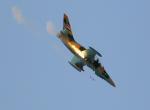By far the largest importer of arms in the world, India is poised to spend an estimated $310 billion (Rs 20.8 lakh crore) by 2022 on upgrading its arsenal. Vying for these sweepstakes are global arms vendors as also domestic suppliers who are exploring all viable options such as forming consortia, joint ventures (JVs), public-private partnerships (PPPs), and outright sales.
Facilitating such partnerships will be the Defence Procurement Procedure (DPP) 2016 launched on 28 March by Defence Minister Manohar Parrikar at the Defence Expo 2016 in Goa. Unveiled before a gathering that included 224 representatives from 48 countries and 1,055 defence-related companies, DPP 2016 seeks to foster a credible Defence Industrial Base (DIB), or military industry, that will serve India’s armed forces as well as exports. Parrikar was confident that the Procedure, effective from 2 April, would ensure probity in, and streamline and simplify, acquisition procedures so as to boost the government’s ‘Make in India’ mission through indigenous design and production of military hardware.
With a resurgent India pursuing robust militarisation that aims at addressing the complex security challenges it faces, its Union Budget 2016-17 presented to Parliament on 29 February apportioned Rs 2.58 lakh crore ($38.4 billion) for the Defence sector. The “guns versus bread” votaries are questioning this largesse, considering that allocations were but Rs 72,394 crore ($1.08 billion) for the Education sector, Rs 38,892 crore ($579 million) for Public Health, and Rs 35,984 crore ($535.5 million) for Agriculture and Farmers’ Welfare.
The Stockholm International Peace Research Institute (SIPRI) rates India the largest importer of arms, with a 14 per cent share in global arms imports between 2011 and 2015. India’s mobilisation has been driven by concerns about the critical gaps in the tactical and strategic defences of its armed forces that have hitherto been largely served by vintage Soviet-era equipment. Another worry has been the concerted expansion of the offensive capabilities of both Pakistan and China on India’s frontiers.
Parrikar has directed his officials to ensure the sanction of 86 pending acquisition proposals worth Rs 1.5 lakh crore ($22.3 billion) within the first quarter of the current fiscal, namely, by 30 June 2016.
Three ‘Make in India’ defence contracts worth $3.7 billion were cleared last May. One was worth $2 billion for joint production of C-295 transport aircraft by Airbus and Tata Advanced Systems (TAS) to replace the IAF’S ageing Avros. The initial order is for 56 aircraft, with options for eight more. UK’s BAE Systems plc is partnering Mahindra Defence Systems (MDS) on a $700 million contract for local production of 145 M777 howitzers for the Indian Army. A joint venture between Russia’s Rostec State Corp. and Hindustan Aeronautics Ltd (HAL) will licence-build 200 Ka-226T twin-engine light multipurpose helicopters, in a deal worth $1 billion and which will replace the ageing Cheetahs and Chetaks - Indian versions of Aérospatiale SA 315B Lama and SA 319 Alouette III – deployed by the Indian armed forces for high-altitude operations, particularly in Siachen.
Imports have hitherto been the mainstay of India’s defences - 70 per cent of the defence capital budget is imported - as generous outlays to the defence public sector undertakings (DPSUs) and the Ministry of Defence’s (MOD’S) Defence Research and Development Organisation (DRDO) failed to nurture any noteworthy military industry.
Curiously, budgetary allocations under capital acquisition are often not fully utilised, resulting in withdrawal at the RE (revised estimates) stage. Of the Rs 35,088 crore ($5.2 billion) forfeited over the past four years, Rs 11,665 crore ($1.7 billion) remained unspent in 2015-16 alone, from an allocation that year of Rs 77,407 crore ($11.5 billion).
While India’s dependence on defence imports seems likely to continue in the foreseeable future, Prime Minister Narendra Modi desires the country to become a major arms exporter, targeting a value of $3 billion within a decade. The fact is that India’s arms purchases far overshadow its exports. Parrikar informed Parliament that “direct payments to foreign vendors for capital acquisitions” for the three services over the previous five years totalled Rs 1.03 lakh crore ($15.4 billion). In contrast, the five DPSUs, four defence shipyards, 39 ordnance factories as well as the private sector combined managed to export defence equipment worth only Rs 1,644 crore ($245 million) in the last three years.
In February, the ‘Make in India’ policy got a boost when two Indian consortia were selected for the Rs 40,000 crore ($5.95 billion) Battlefield Management System (BMS) contract for integrating all surveillance resources available at the battalion or regiment level, including from locally launched UAVs and ground sensors. Fourteen contenders had formed four consortia to vie for this prestigious contract. The two selected - one comprising Tata Power Strategic Engineering Division (SED) and L&T, and the other, Rolta India and the DPSU, Bharat Electricals Ltd (BEL) – will each develop four BMS prototypes for mountain, jungle, plains and desert operations. The BMS will pinpoint the locations of Indian and enemy troops and key weapons platforms as well as facilitate terrain analysis to achieve improved situational awareness.
Tata Power SED-L&T alongwith the consortium of HCL Infosystems-BEL have been selected for another major contract, the Rs10,000 crore ($1.5 billion) Tactical Communication System (TCS), which will replace the ageing Army Radio Engineering Network (AREN). It was in 1996 that the Army had sought to replace this backbone of its communication grid on an urgent and critical basis. The two selected teams will build two prototypes of the TCS, seven of which will be produced for the seven army commands. The two prototypes will be put to trials and the selected competitor will produce the entire TCS.
Ten Indian companies that have formed consortia are aspiring for the country’s largest ever indigenous contract, for the Rs 60,000 crore ($8.93 billion) worth of supply of 2,610 Future Infantry Combat Vehicles (FICVs). While Tata Motors has entered into a strategic agreement with Bharat Forge Ltd and the US’s General Dynamics Land Systems (GDLS), L&T has tied up with Mahindra. Tata Power SED is going it alone, while the others include Reliance Defence, Rolta, Punj Lloyd, Titagarh Wagons and the public sector Ordnance Factory Board (OFB).
This contract was conceived in 2009, but the letter of intent (LoI) was suddenly withdrawn in 2012, only to be revived recently. The FICV will be an amphibious, armoured, tracked and air-transportable troop-carrier that can fire 4-km range anti-tank missiles and will replace the Indian Army’s Russian-made BMP II second-generation infantry fighting vehicles in use since the 1980s. Each of the three shortlisted consortia will develop an FICV prototype, with the Defence ministry contributing 80 per cent of the cost.
The Tata Group is among those Indian companies positioning themselves to take advantage of the military bounty. India’s largest private sector conglomerate with $108.8 billion (Rs 7.3 lakh crore) revenue in 2014-15 is investing substantially in this field and its defence and aerospace business expects to earn Rs 2,650 crore in 2015-16. For instance, Tata Power SED, which has a Rs 500 crore ($74.4 million) facility in Bangalore, is setting up a new factory of a like amount at Vemagal in Karnataka. The unit will open next year, and a further Rs 200 crore ($29.8 million) will be invested in the second phase. The Group’s 14 companies engaged in the sector have an order book exceeding $1.3 billion. Vernon Noronha, vice-president of Tata Motors’ defence & government business, sees defence contributing 15 per cent to his company’s revenue from the current 3 per cent if it wins the FICV order.
The latest Indian company to foray into defence is the $10 billion diversified Adani Group, with its newly-formed subsidiary, Adani Aero Defence Systems & Technologies Ltd, signing a statement of intent on 30 March with Israel’s Elbit-ISTAR and Bangalore’s Alpha Design Technologies Pvt Ltd to collaborate on Unmanned Aircraft Systems (UAS). Adani believes UAS will be the next frontier of technology, providing multi-functional capability, especially that of ‘see & hear’, to provide information advantage to the military and net security providers.
Anil Ambani-controlled Reliance Infrastructure entered the defence sector last year by picking up an 18 per cent stake in Pipavav Defence and Offshore Engineering Company Ltd for Rs 819 crore, after announcing plans to acquire a controlling stake for up to Rs 2,082 crore. It followed up in December with an additional 17 per cent for Rs 850 crore and made an open offer for a further 26 per cent.
L&T, the Rs 57,164 crore ($9.22 billion) turnover engineering & construction giant, sees award opportunity of $18-20 billion each in army and navy. Since 2002, L&T is India’s only corporate with licences to manufacture the entire range of defence equipment for all four services, including the Coast Guard. The company fabricated the hull and other critical components of India’s first indigenous nuclear-powered submarine, Arihant, and has invested Rs 3,989 crore ($594 million) in the 1,225-acre Kutapalli shipyard on the east coast where it intends to build the P 75I submarines – if it wins the imminent contract estimated at between $8-10 billion – and other naval orders.
India’s largest defence deal was to have been the $22 billion contract won in January 2012 by France’s Dassault Aviation for 126 Rafale medium multi-role combat aircraft (MMRCA) for the Indian Air Force (IAF). The process began in 2005 with a request for information (RFI) issued by the IAF for a new frontline jetfighter to replace the out-of-date Soviet-built MiG-21s that had been its mainstay since the early ‘80s. The IAF is hamstrung by a depleted fleet of just 34 combat squadrons against the authorised strength of 42. Negotiations had stalled over pricing and the guarantee clause, when Prime Minister Narendra Modi, on his April 2015 visit to France, officiated the outright purchase of 36 Rafales at an as yet undetermined price. It is unclear as to what will happen to the rest of the MMRCA deal, which originally entailed outright purchase of 18 Rafales, the remaining 108 to be built under transfer of technology by HAL.
France’s other major on-going military programme with India is the Rs 23,560 crore ($3.73 billion) transfer of technology Project 75 (P 75) by its state-owned DCNS with India’s public sector Mazagon Dock Ltd (MDL) for constructing six Scorpene attack submarines. The first submarine, Kalvari, is set for launch in September and for commissioning a year thereafter, the remaining five joining service at intervals of one year.
The Indian Navy has a particularly robust programme of modernisation, with 41 ships on order from Indian yards at a combined cost of Rs1.09 lakh crore (about $16 billion), including P 75.
DCNS, MDL and other defence-oriented enterprises like L&T and RDEL, which have invested heavily in creating and expanding their warship-building competencies, are also aspiring for the imminent Rs 50,000 crore ($7.44 billion) P 75 India (P 75I) tender for building six more diesel-electric submarines.
Last September, India signed a $2.5 billion deal with Boeing for procuring 22 Apache AH-64E combat and 15 Chinook CH-47F heavy lift helicopters. With large sections of the Chinook fuselage already being made in India and talks on to make Apache parts as well, Boeing Chairman Jim McNerney said his company may assemble either of these helicopters in India and also proposed to manufacture a current fighter jet of Boeing in the country.
Russia, according to SIPRI, remains India’s steadfast arms supplier, accounting for 70 per cent of India’s arms imports between 2011 and 2015. India, in turn, remains the largest purchaser of Russian arms, with 39 per cent of Moscow’s military exports in the same five-year period. “Based on existing orders and weapons, Russia will remain, by a significant distance, the main supplier of major arms to India for the foreseeable future,” the SIPRI report adds. Last December, India’s Defence Acquisition Council (DAC) cleared the purchase of five Russian S-400 Triumph (NATO reporting name SA-21 Growler) missile defence systems estimated at Rs40,000 crore ($6 billion). India could reportedly buy 12 of these 400-km range surface-to-air missiles that can simultaneously engage up to 36 targets at once, like tactical and strategic aircraft as well as ballistic and cruise missiles, firing 72 missiles toward them. China is the first buyer of S-400, which is one of the advanced anti-aircraft missile systems in the Russian inventory.
The DRDO and Israeli Aerospace Industries (IAI) are partnering on the Rs 10,076 crore ($1.5 billion) project for developing a medium-range surface-to-air missile (MR-SAM) system for the IAF and on the Rs 2,606 crore ($388 million) project for developing a long-range SAM (LR-SAM) for both the Indian and Israeli armed forces. Both the SAM systems will be inducted from this year.
There is a growing view that India needs to adequately militarise in the context of the threat scenario it confronts on two fronts. Apart from defence modernisation and indigenisation, it needs to focus on future technologies like stealth, unmanned systems, satellite surveillance and cyber-warfare. China, for instance, is a generation ahead when it comes to militarisation and the gap is increasing. Beijing has successfully raised indigenisation after decades of dependence on Soviet imports and reverse engineering. China also supplies more than half the defence equipment required by Pakistan under ‘the enemy of my enemy is my friend’ theory.
(In this article, (US Dollar) US$1 = (Indian Rupees) Rs67.2)
Published Date: 7th May 2016, Image Source:http://www.economictimes.indiatimes.com
(Disclaimer: The views and opinions expressed in this article are those of the author and do not necessarily reflect the official policy or position of the Vivekananda International Foundation)










Post new comment